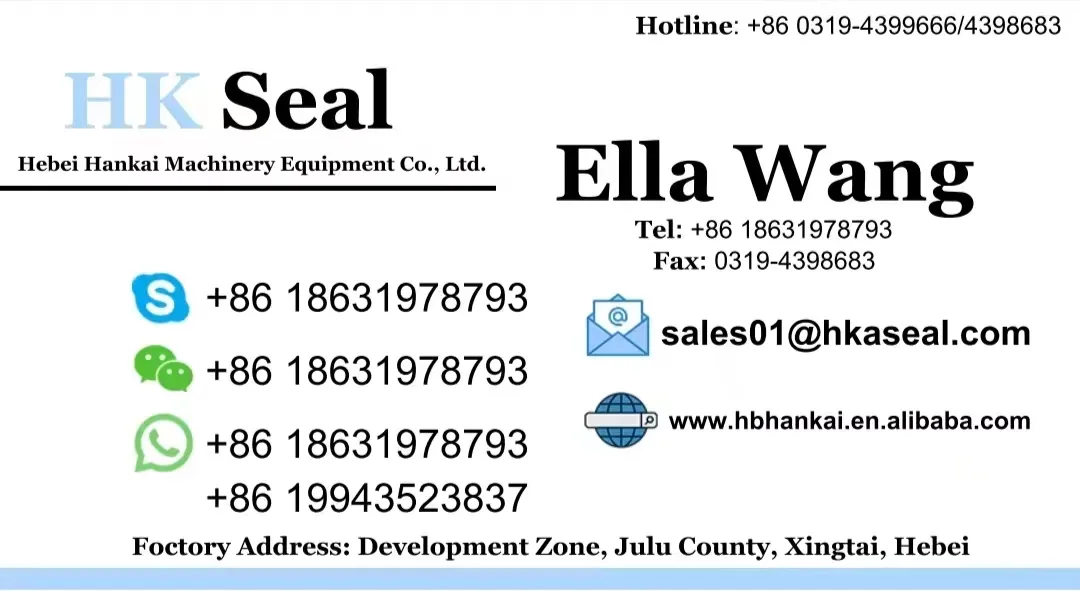ਅਕਤੂਃ . 11, 2024 04:34 Back to list
Understanding Wiper Seals and Their Importance in Machinery Maintenance
Understanding Wiper Seals Importance, Types, and Maintenance
Wiper seals are critical components in various machinery and equipment, particularly in hydraulic systems and automotive applications. They serve as barriers that prevent the ingress of dirt, dust, and other contaminants, while also retaining lubricants and hydraulic fluids necessary for optimal operation. In this article, we will explore the importance of wiper seals, the different types available, and tips for their maintenance.
Importance of Wiper Seals
Wiper seals play an essential role in ensuring the longevity and efficiency of equipment. They are primarily designed to protect moving parts from external elements that can cause wear and tear. For instance, in hydraulic cylinders, a wiper seal prevents debris from entering the cylinder, which could lead to premature failure or reduced performance. By keeping contaminants out, wiper seals help maintain the integrity of hydraulic fluids, ensuring smooth operation and reducing the risk of costly repairs.
In automotive applications, wiper seals are involved in the functioning of windscreen wipers and other moving parts. They help to cover gaps that could allow water and debris to enter sensitive areas, such as the motor or electronic components. The significance of wiper seals cannot be overstated; they are pivotal in maintaining the performance and reliability of many systems.
Types of Wiper Seals
Wiper seals come in various designs tailored to meet specific applications and performance requirements. Here are some common types of wiper seals
1. U-Cup Wipers These seals are shaped like a 'U' and are often used in hydraulic cylinders. They offer excellent sealing capabilities and are suited for high-pressure applications.
2. V-Ring Wipers These seals are flexible and can accommodate slight misalignments between the mating surfaces. They are particularly useful in applications where rotational movement is involved.
3. Lip Seals These seals have a lip that presses against the moving part to create a tight seal. They are common in both automotive and industrial applications due to their ability to provide a reliable seal while allowing for movement.
wiper seals

4. Flat Wipers These are simple seals made from rubber or other materials. They are typically used to wipe away dirt and debris from surfaces, ensuring the function of other seals is not compromised.
Maintenance of Wiper Seals
To ensure the optimal performance of wiper seals, regular maintenance is essential. Here are some practical tips to consider
1. Regular Inspection Periodically check wiper seals for signs of wear, such as cracks, tears, or hardening of the material. Early detection of issues can prevent more significant problems down the line.
2. Clean Surrounding Areas Keep the areas around wiper seals clean and free of debris. Dirt and contaminants can quickly degrade seal performance, leading to leaks and failure.
3. Proper Installation Ensure wiper seals are correctly installed according to the manufacturer’s specifications. Improper installation can lead to premature wear and failure.
4. Use Compatible Materials When replacing wiper seals, select materials compatible with the fluids they will be exposed to. For example, nitrile rubber is suitable for oil-based fluids, while fluorocarbon materials are better for aggressive chemicals.
5. Monitor Performance Keep an eye on the performance of the equipment. If there are signs of hydraulic fluid leakage or diminished functionality, it could indicate a problem with the wiper seals.
Conclusion
Wiper seals may seem like small components, but they play a significant role in the reliability and efficiency of various systems. Understanding their importance, types, and maintenance can greatly enhance equipment performance and lifespan. By taking proper care of wiper seals, you can help ensure that your machinery operates smoothly and effectively, ultimately leading to increased productivity and reduced operational costs.
-
TCN Oil Seal Metal Ring Reinforcement for Heavy Machinery
NewsJul.25,2025
-
Rotary Lip Seal Spring-Loaded Design for High-Speed Applications
NewsJul.25,2025
-
Hydraulic Cylinder Seals Polyurethane Material for High-Impact Jobs
NewsJul.25,2025
-
High Pressure Oil Seal Polyurethane Coating Wear Resistance
NewsJul.25,2025
-
Dust Proof Seal Double Lip Design for Construction Equipment
NewsJul.25,2025
-
Hub Seal Polyurethane Wear Resistance in Agricultural Vehicles
NewsJul.25,2025
-
The Trans-formative Journey of Wheel Hub Oil Seals
NewsJun.06,2025
Products categories
















